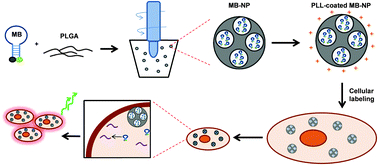Molecular beacon-loaded polymeric nanoparticles for non-invasive imaging of mRNA expression†
Abstract
Assessment of intracellular mRNA expression is invaluable for understanding cellular signaling activities, identifying disease stages, and monitoring the gene expression pattern of therapeutic cells during their culture, expansion and/or differentiation process. Previous methods suffer from the need to disrupt the biological samples to perform polymerase chain reaction analysis which can be laborious, fragmented and destructive. Herein, we develop a mRNA nanosensor based on the sustained release of mRNA-specific molecular beacons (probes that fluoresce upon hybridization) from the biodegradable poly(D,L-lactide-co-glycolide) nanoparticles. Post cellular internalization, the particles gradually degrade and release the encapsulated probes which are initially weakly fluorescent. When the released probes meet and hybridize with target mRNA, they restore pre-quenched fluorescence. By virtue of quantifying the fluorescence intensity, we can estimate the cellular mRNA expression. As a case study, β-actin mRNA expression in mesenchymal stem cells cultured on a 3D matrix was monitored and compared with those cultured on a 2D plate for one week. Critically, the observed expression profile shows a great correlation with the established quantitative polymerase chain reaction analysis.


 Please wait while we load your content...
Please wait while we load your content...